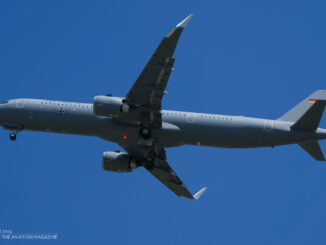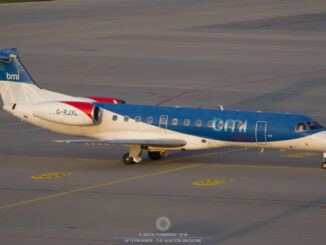 In the centre of Schleswig harbour, one may come across an intriguing monument – a boulder with a memorial tablet commemorating the last operational flight of Luftwaffe, the air arm of the German armed forces before and during the World War II. However, what really catches the eye is the date of the flight – 18th June 1945. And that means more than a month after the official end of the war in Europe and fall of the Third Reich.
In the centre of Schleswig harbour, one may come across an intriguing monument – a boulder with a memorial tablet commemorating the last operational flight of Luftwaffe, the air arm of the German armed forces before and during the World War II. However, what really catches the eye is the date of the flight – 18th June 1945. And that means more than a month after the official end of the war in Europe and fall of the Third Reich.
In order to understand how such a flight could happen so long after the guns went silent in Europe, one must go back to April of 1939. It was the time when the German armed forces created the first Seenotstaffel (Sea Rescue Squadron). The unit was formed in Bad Zwischenahn, in the vicinity of Oldenburg, but in summer of the same year was transferred to the North Sea island, Norderney. Officially, Seenotstaffel 1 ´Norderney´, began its operations on 1st August 1939, equipped with six Heinkel He 59 – a twin-engine biplane, able to operate with conventional landing gear or two floats.
Initially, the main task of the squadron was to rescue shipwreck survivors. The He 59 biplanes used by Seenotstaffeln were specially tailored for rescue operations. Their equipment included a special rear hatch, inflatable boats and a rescue winch.
Over the next years, Germany established further nine sea rescue aviation units. The last of them was Seenotstaffel 10, formed in 1942, in Tromsø (occupied Norway). Among the aircraft operated by the rescue squadrons there were Junkers W 34s, Dornier Do 18s and Do 24s, Heinkel He 60s and He 115s, as well as a captured Bréguet Br 521.
At the beginning of the war, the rescue He 59 were painted all-white and carried the red cross markings. Reportedly, a few of them were shot down by the British aircraft in 1940, therefore a standard Luftwaffe camouflage was implemented later, and the aeroplanes armed.

During the war, the German Seenotstaffeln units were deployed to different operation areas across Europe. They operated from both Germany occupied areas and other Axis countries – among their base locations were Cherbourg, Schellingwoude, Stavanger, Portofino, Venice, Warna, Mamaia, Thessaloniki, Athens, Sevastopol and Lipau (nowadays Liepāja, in Latvia).
In August of 1944, the sea rescue service was reorganised. The initially independent air squadrons and rescue boat flotillas were merged into Seenotgruppen (Sea Rescue Groups), each containing one aircraft and one ship unit. As a result, four squadrons were disbanded and the remaining received new numbers 50, 51, 60, 70, 80 and 81 – same as their Seenotgruppe.
After the reorganisation, Seenotstaffel 81 was assigned to Bug air naval station, on the island of Rügen. The squadron was equipped with fourteen Dornier Do 24 flying boats and operated over the Baltic Sea, using Grossenbrode, Kamp (nowadays Kępa, in Poland), Nest (now Unieście, in Poland) and Pillau (now Baltiysk/Балти́йск, in Russia) as its forward locations.
In 1945, due to the Soviet advance, many German civilians tried to escape from the East Prussia and other coastal areas of the Baltic Sea. Their evacuation was mostly organized and performed by Kriegsmarine (the German Navy). Nevertheless, the sea rescue squadrons also took part in that effort.
Many of those civilians were directed to air base located at Kamper See (nowadays Resko Przymorskie lake, in Poland), including hundreds of children evacuated there within Kinderlandverschickung action (a short term for ´relocation of children to the countryside´), aimed to move the children away from big cities, due to risk of air raids. Then, the civilians were evacuated by air to Rügen and Schleswig-Holstein – according to the eyewitness accounts, there were days when the aircraft were taking-off from the base in fifteen minutes intervals, usually packed with refugees.

On 5th March 1945, one of the Do 24T-3 of Seenotstaffel 81 took-off with approximately 80 people on board, including the crew. This was far beyond the usual capacity of the aircraft as it was not designed to carry so many passengers. After reaching an altitude of about 260 feet, the overloaded aeroplane ditched into the lake, killing all people on board but one. Nevertheless, some investigation that was done on the wreckage in the 2000s moved towards a theory the Do 24 was shot down by the Soviet troops.
Seenotstaffel 81 continued the evacuation effort until almost the very end of the war. On 5th May, shortly before taking over the Bug naval station by the Soviets, the squadron – followed by its supply ship BP 41 – was evacuated to Guldborgsund strait, between the Danish islands of Lolland and Falster. There, Seenotstaffel 81 was caught by the German capitulation. Shortly after, the squadron personnel surrendered to the British troops.
Nevertheless, the end of the World War II did not mean the end of problems it caused. Several German troops and approximately 250,000 civilian refugees were still staying in Denmark. Although they created a huge issue for the country, the British occupation force decided that the refugees must stay in Denmark until situation in Germany is fully controlled and consolidated (in fact, organized mass return of the German refugees began only in November of 1945).
Therefore, it was no wonder that the Danish authorities welcomed the idea of return flight of Seenotstaffel 81 to Germany, especially that the squadron aircraft were ordered to take onboard as many Germans, as only possible. The necessary arrangements between the British occupation forces, Danish administration and the German naval aviators were made and soon, on 18th June 1945, Seenotstaffel 81 began its return flight to Germany.

All fifteen Do 24s of the squadron flew back to Schleswig-Holstein and landed on Schlei fjord, close to Schleswig harbour. The aircraft took back approximately 1,000 people, including wounded soldiers and refugees. During the flight, Seenotstaffel 81 was escorted by the British Hawker Typhoon fighters from No. 175 and No. 184 Squadron RAF, at that time being based at Schleswig/Jagel airfield.
Although the Third Reich and its armed forces ceased to exist on 8th May 1945, the flight from 18th June is widely considered as the last official operation of the so-called ´first Luftwaffe´ (1935-1945). This thesis is supported by the fact that Seenotstaffel 81 made the flight led by its commander Karl Born, all crew members were uniformed, and the official structure of the unit was observed. Moreover, the aircraft were still carrying Luftwaffe markings – only the Nazi insignia on the aircraft tails were removed – with additional red cross added on the fuselage.
It should to be mentioned here that after 18th June 1945, a few other flights, performed by Luftwaffe personnel, were reported. However, none of them was done under the German command and with preserving the original markings. Usually, those operations included transfer of the German aircraft to the Allied forces for evaluation, and they were already carrying the Allied identification signs.
The last Do 24 of Seenotstaffel 81 landed on Schlei on 2:45 p.m., local time. On the next day, the supply ship arrived to Schleswig, carrying the ground personnel and crews´ family members, as well as the last squadron aircraft, an Arado Ar 196.
Only after that, Karl Born called the squadron for its last assembly and Seenotstaffel 81 was officially disbanded on 19th June 1945. The squadron aircraft were left abandoned on waters of Schlei.

Nowadays, events from July of 1945 are commemorated by the small monument in Schleswig harbour. The plaque translated to English, says:
For Historical Memory
On 18th June 1945, 15 Dornier Do 24 flying boats from Sea Rescue Group 81 landed here on the waters of the Schlei, with a total of approximately 1,000 people, including 450 wounded German soldiers.
They came under the protection of English fighter pilots from Bug/Rügen via Guldborg/Denmark.
It was the last flight of a unit of the German Air Force (Sea).




